This post may contain affiliate links, from which we earn an income. Click here to read our affiliate policy.
Are you planning a European tour in a sizeable motorhome? Remember that toll regulations across Europe alter significantly once your vehicle surpasses a gross vehicle weight of 3,500kgs.
For the past five years, we’ve journeyed across Europe in two motorhomes and an overland truck, each exceeding the 3,500kg mark, and we’ve researched European motorhome tolls so you don’t have to!
Find out what you should do in each country to ensure you’re covered to drive on toll roads with our guide to heavy motorhome tolls in Europe.
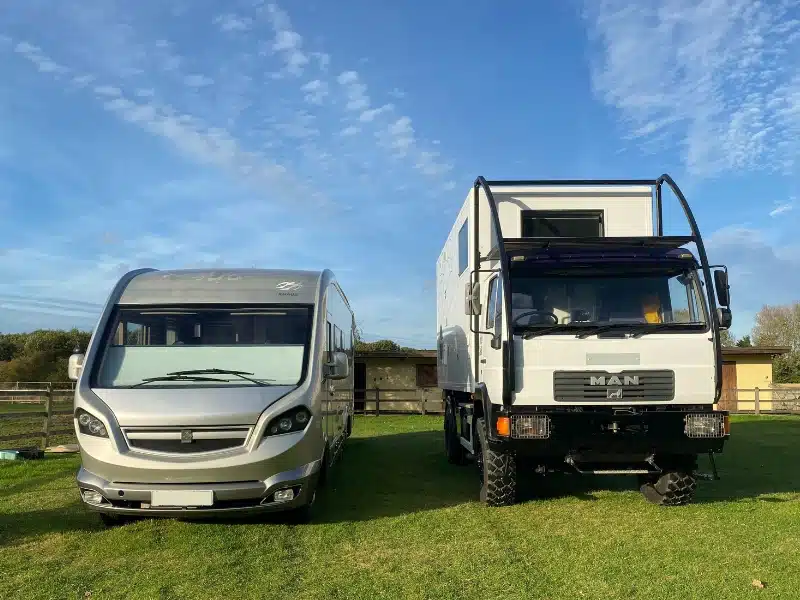
Motorhome Tolls in Europe for Vans >3,500kgs
If you’re planning on hiring a motorhome in any European country, check with the motorhome hire company about paying tolls. Depending on the country and method of toll collection, you may need to make your own arrangements.
Albania
There is only one toll road in Albania. The A1 Durres to Kosovo motorway is 114 kilometres and starts from the port city of Durres and ends at the border with Kosovo.
Toll fees, regardless of weight, are calculated on the number of axles, and are paid at the toll plaza. You can pay in LEK or euros (only notes for the latter and change will be given in LEK) or a debit or credit card.
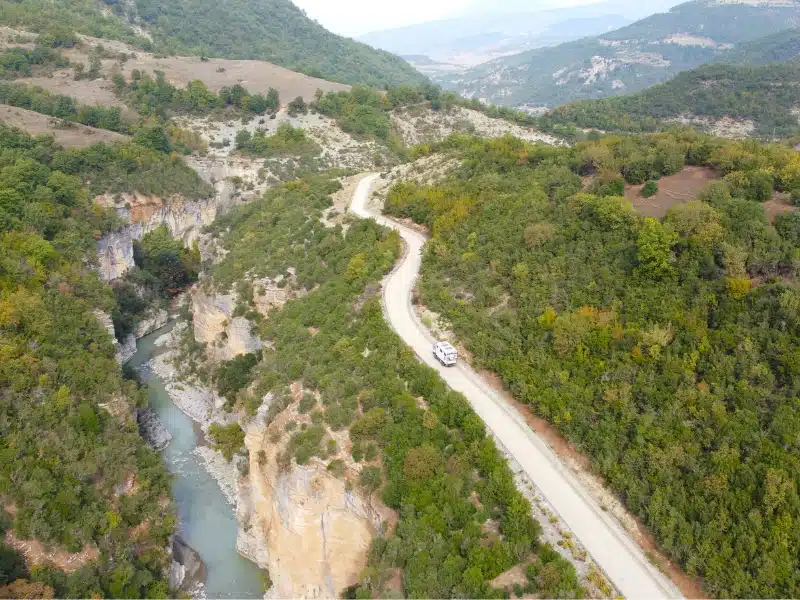
Andorra
There are no general road tolls in Andorra except the 2,879 meters long Tunnel d’Envalira on the access route from France. Charges are determined by the height, weight and number of axles your motorhome has. Payment is with cash or credit card at the toll booth.
Austria
To use any of Austria’s motorways all vehicles with a technically permissible maximum laden mass (TPMLM) of over 3.5 tons must use an onboard unit (OBU) called a GO-Box, issued by ASFiNAG.
The GO-Box is an electronic device that is installed in the vehicle. It uses microwave technology to communicate with the toll gantries and automatically ensures the payment of the toll. The toll fees are dependent on the number of axles and the EURO emission class of your vehicle, so the cleaner your vehicle, the less you pay.
There are 175 outlets around Austria, with many near borders, where you can collect and drop off an on board unit. You must have your V5 registration document and certificate of conformity to show the emissions class of the vehicle.
Vehicles that were first registered before 1st July 2019 are automatically assigned to CO₂ emission class 1. You can check your vehicle’s emission class here, and upload the necessary verification documents.
You can get a GO-Box immediately at any GO-Box point of sale with a €5 deposit, and choose whether to pre-pay (with a minimum top-up of €75) or link the OBU to a credit card for post-payment.
Once you have the GO-Box, you can use the details to create an account where you can see tolls and transactions, or top-up more funds. When you drop the box off your €5 deposit will be returned along with any monies you have not used to cover toll fees.
The Austrian authorities are sticklers for any vehicles over 3.5 tonnes using a GO-Box. If you are caught without one fines can be hefty.

Belgium
The good news is that whilst Belgium does operate toll roads, fees only apply to heavy goods vehicles over 3,500ks. Motorhomes are exempt from this category as they are a private vehicles and do not carry goods.
RELATED POST: Motorhome Stopovers & Travel in Belgium
Bosnia & Herzegovina
There are just four toll roads in Bosnia and Herzegovina: the A1 near Sarajevo: Zenica – Bradina; A1 near Mostar: Medugorje – Ljubuški; E661: Banja Luka – Gradisk; and the motorway between Banja Luka and Doboj.
Vehicles are charged by their class, with motorhomes that have two or three axles weighing over 3,500kg being categorised as class 3, or klasa III.
The toll is at the toll stations using the Bosnian currency BAM or in Euros. Almost all toll stations offer payment by debit and credit card.
Bulgaria
From February 2024, all campers and motorhome sregardless of gross vehcile weight are exempt from needing an on board unit or route card. Motorhomes may now purchase an e-vignette to cover motorway travel in Bulgaria. This article from BG Toll explains the changes in the law.
For the best price use this link to Bulgaria’s official e-vignette website. Although the site still refers to vehciles <3.5t, you may still purchase an e-vignette or a motorhome of any weight.
Croatia
Tolls for vehicles with a maximum authorised mass exceeding 3,500kg are paid in the same way as for passenger cars, by manual payment at toll gates. This can be in cash or with a debit or credit card.
The vehicle category for determining the cost of tolls in Croatia is determined according to the number of axles of the vehicle. Motorhomes with two or three axles are determined to be class 3.
Czech Republic
Our nemeses! We love the Czech Republic but don’t love the mandatory use of a Myto CZ onboard unit when travelling there!
All road motor vehicles with at least four wheels and having a maximum permissible weight of more than 3.5 tons including motorhomes, caravans and camper, are subject to toll collection on motorways and some class 1 roads.
The onboard units are easy enough to obtain at each service station after a border crossing. You pay the €100 deposit and top up with an amount – the staff will help with the likely costs – and you’re on your way.
The difficulty comes with dropping the unit off. We were unable to find a service point anywhere on the map they provided us with that would accept a return of the box. We were told we needed to go into the nearest town and return the OBU to the highways office!
We still had the box a year after leaving Czechia when we received a letter asking us to return it or our account would be cancelled. Needless to say, it went into the bin instead!
In mid-2024 a readre contacted us to share her very positive experience, thanks Ewa!
“We got the e-toll device from their distribution point (a petrol station). There is a comprehensive interactive list of distribution and contact points on their website and a downloadable PDF on the same page. I found the latter easier as you can search for a specific country code to find return points just across the Czech border with another country to make sure you return the device having paid all the tolls right up to the border.
In our case, we did it immediately after crossing the border to Poland where there was a little portacabin with a Myto CZ sign on it. When I took the device in, they returned everything straight onto my credit card, i.e. the device deposit and any unused credit and gave me receipts confirming it’s been done. After a few days all appeared on my card.”

Denmark
In Denmark, only heavy goods vehicles weighing over 12 tonnes are subject to tolls on motorways. There isn’t a specific toll system for cars or motorhomes, but that doesn’t imply free usage of all roads.
Toll charges are imposed for crossing specific bridges on Zealand Island in the Baltic Sea due to their significance as vital traffic links. These include the Crown Princess Mary’s Bridge over the Roskilde Fjord, the Storebælt Bridge over the Great Belt and the Øresund Bridge, a bridge-tunnel combination between Copenhagen and Malmö in Sweden.
Vehicles, including motorhomes, are measured by height and length when determining the toll price to be paid. You can get a discount on the rate by buying a toll ticket in advance for each bridge, or you can pay the full price in cash or by card at the crossing.
On the Crown Princess Mary’s Bridge, the vehicle’s licence plate is recorded, and the invoice is sent by post. Alternatively, you can use electronic payment options such as AutoPass from Norway or Bizz from Brobizz A/S.
Estonia
After a reader contacted us (thanks Peter!) we have changed our advice and now know that heavy motorhomes are exempt from toll fees in Estonia.
Estonian Transport Administration states “The road user charge is payable for all heavy goods vehicles that weigh over 3.5 tonnes (categories N2, N3) and are used on public roads.”. This clearly and unambiguously clarifies that motorhomes (which are category M1) do not pay the tolls.
Finland
Yay…there are no, that’s zero, nada, nada, toll roads in Finland. Right, that’s our next stop!
France
We all know that France’s peage roads are excellent but super expensive, especially if you’re in a heavyweight motorhome.
The technical measurement that French motorway tolls use to determine whether your motorhome is Category 2 or 3 is height and weight: anything over 3m high or heavier than 3,500kg is a Cat 3.
You might get away with pressing the telecoms button at the booth and saying je suis un camping car (I am a camping car). If you’re lucky the operator will change your category to 2, which will be significantly cheaper. Our experience would suggest this might work if you’re in an A-Class but unlikely if you’re in an overland truck.
You may want to consider carrying an electronic toll tag, like the TollTickets toll box (you can also get a version which covers Italy, Spain and Portugal too) that deducts the fees from a credit card automatically, meaning you don’t have to stop at a booth or barrier.
RELATED POST: Motorhoming in France: Your Complete Touring Guide for 2024
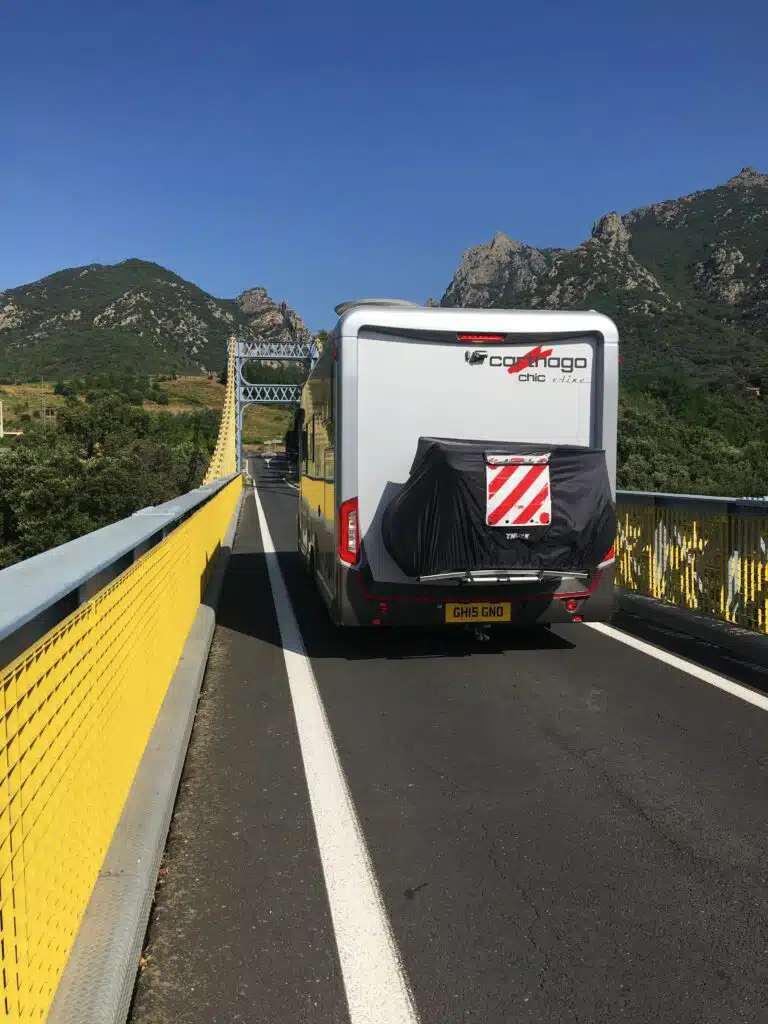
Germany
There are no tolls to pay on the motorways here, making autobahn routes through Germany a really cost-effective way to access Italy, Switzerland, Austria, Liechtenstein, Czech Republic and Poland.
If you are travelling in a motorhome that is over 7,500kg, like an RV, overland truck or converted lorry, and not carrying goods, then you are exempt from the tolls placed on lorries over this weight.
The toll-collect.de website states the following;
Vehicles that do not fall under the legal definition of a vehicle subject to toll (according to § 1 Paragraph 1 Clause 2 of the German Federal Trunk Road Toll Act (BFStrMG)):
a) are neither structurally intended for road haulage (e.g. self-propelled working machines);
b) nor used for commercial road haulage or own-account transport operations for charged or business-related transportation of goods (in accordance with Section 1 of the German Road Haulage Act (GüKG)).
Toll exemption only results when both requirements are fulfilled. Otherwise, registration as a toll-exempt vehicle is not possible. Registering your vehicle as toll-exempt is not obligatory, although it may allow you to avoid unnecessary checks.
RELATED POST: Motorhoming in Germany: Your Complete Touring Guide for 2024
Greece
Tolls in Greece are levied for most motorways, the Rio-Antirrio Bridge and the Aktio-Preveza Tunnel. In Greece, you pay a fixed amount in advance to access to motorway, there are no payment booths as you exit.
Most motorhomes and campervans, even those over 3,500kgs will generally be classed as Category 3, which covers vehicles with two or three axles, with or without trailers, and over 2.2m high.
Tolls can be paid by cash or card at the toll booth, or with an electronic toll tag. The latter is complicated as there are six separate motorway toll providers in Greece and the tags are not always transferable.
RELATED POST: Motorhome & Campervan Greece – Complete Guide
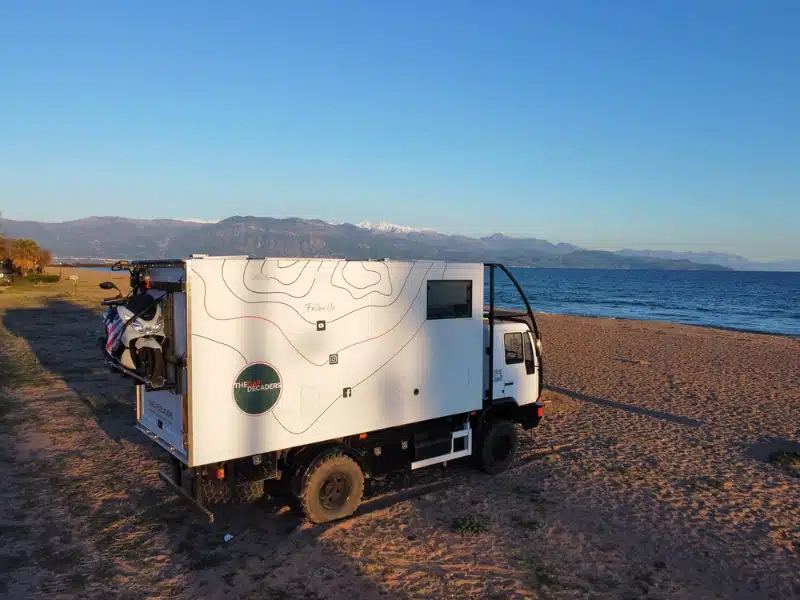
Hungary
Motorhomes over 3,500kgs were exempt from using the e-toll system until 1st January 2024. A new law now means that motorhomes over the 3.5T limit can no longer buy an E-vignette, but must use the E-toll system instead.
The E-toll system is managed by HU-GO and comprises an onboard unit offer alongside a Route Ticket option. The latter can be purchased online in a fairly easy-to-use website portal. You must provide the usual details, and select the ‘J’ category of your motorhome – J2 for two axles and J3 if you have three axles.
All Route Tickets are valid from the time of purchase until midnight the following day. Purchase another if you want to stay longer.
Iceland
The only toll road in Iceland is the Vaðlaheiðargöng tunnel on Route 1 east of Akureyri in the north of the country. Journeys must be registered within three hours of using the tunnel and payment made at the Veggjald website with a credit card. If you miss this payment window, you’ll receive a bill in the post with an increased toll fare plus a fine for not paying in time.
Heavy vehciles fall into two categories – those between 3,500kg and 7,500kg and those over 7,500kg. There are no special toll rates for motorhomes.
Italy
Not all Italian autostradas have tolls, or only have them on some sections. Motorhomes tolls are calculated for a class B vehicle, regardless of the number of axles or weight.
Toll roads are pay-as-you-go, try and avoid using large notes. If the machine has no change, it will give you a credit note which you can exchange for cash at some obscure highways office in a random town, where there will be no motorhome parking and no one will understand your bad Italian. Use the correct money or your credit card!
RELATED POST: Motorhoming in Italy: Your Complete 2024 Guide
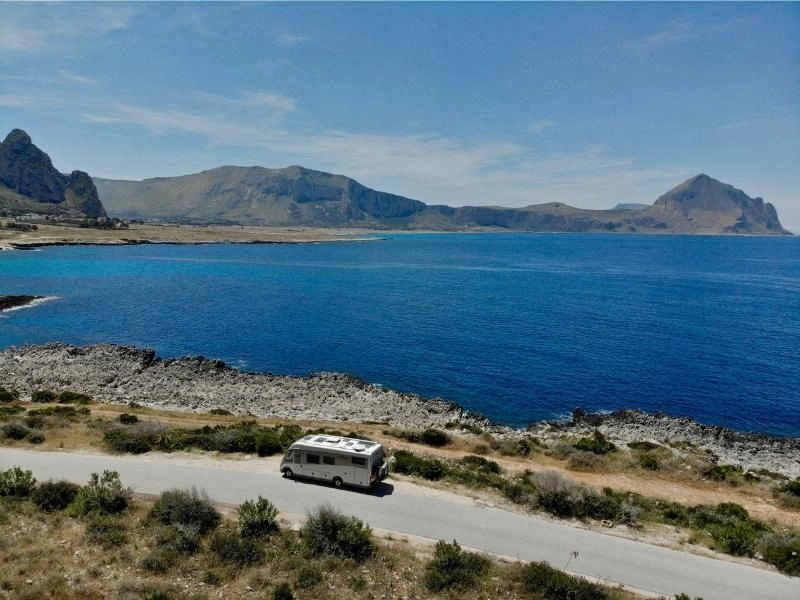
Ireland
There are eleven toll roads in the Republic of Ireland, all of which originate from Dublin. There is no specific class for motorhomes weighing over 3.5t, they are deemed to be the same as a car.
Ten of Ireland’s eleven toll roads have conventional toll plazas with barriers where you can pay the toll fee in cash or with a card. Dublin’s M50 toll plaza is barrier-free and you can pay online here.
If you’re touring in Ireland and Toll Tag account means you can sail through the toll barriers and pay directly from a credit card in your account.
RELATED POST: Motorhoming in Ireland – A Complete Guide
Kosovo
In Kosovo, toll roads, motorways, and expressways don’t require any toll charges, regardless of how much your motorhome weighs. You can travel across the entire country without needing a vignette or tag transponder.
Latvia
Motorhomes over 3,500kgs can use most motorways and expressways in Latvia including bridges to Lithuania, free of charge without needing to buy a vignette. The only exception is the coastal resort of Jurmala, where an environmental fee can be paid by cash or credit card.
Liechtenstein
There are no toll roads in Liechtenstein. However, be cautious around the borders as you may slip across into Austria or Switzerland without realising, and be in breech of their very strict toll regulations.
Lithuania
There are no tolls payable for motorhomes falling into the M1 category, regardless of weight.
Luxembourg
Motorways in Luxembourg are toll-free for private vehicles regardless of gross vehicle weight.
Macedonia
Tolls are applied on the A1 and A2 highways connecting Skopje, the capital of North Macedonia, to further regions of the country. These tolls are collected at toll booths and can be paid either in Euros or by credit card.
Vehicle toll rates are categorized based on the height above the first axle and the number of axles.
Montenegro
In Montenegro, a toll for all vehicles is charged on a 42km section of the A1 motorway between Smokovaca and Mateševa, and for the 4km Sozina Tunnel on the E 80 between Podgorica and Bar.
Motor vehicles up to 3 axles, over 3.5 tonnes and over 1.9 metres in height are deemed to be class 4. Tolls can be paid in euros or with a credit card at the toll booths.
Netherlands
You’ll find various sites online stating that HGVs weighing over 12,000kgs are required to pay a toll by EuroVignette in the Netherlands.
However, motorhomes are actually exempt from this charge because they do not carry goods. The Netherlands Belastingdienst (tax authorities) state the following:
If you have a truck (or combination), you usually have to pay heavy motor vehicle tax (BZM) in addition to motor vehicle tax. You pay BZM if you want to use your truck (combination) on the motorway and meet both of the following conditions:
- The truck (combination) is intended for or used for the transport of goods. Goods transport also includes the transport of (live) animals.
- The permitted maximum mass of the truck (combination) is 12,000 kg or more.
Because your motorhome is not designed nor intended to transport goods, you do not meet both of the conditions and are therefore exempt from needing a EuroVignette. As the Netherlands does not toll cars and motorhomes under 3,500kgs, there is nothing to pay.
Norway
Of all the European countries, we think Norway and Portugal have the most complicated toll arrangements.
The good news is that motorhomes are exempt from requiring a special HGV toll tag. The AutoPASS website states:
All foreign vehicles with a total permitted weight exceeding 3.5 tons registered to a business, government, county municipality or municipality, or which in other ways is used for business, must for all operation on public roads be equipped with a valid toll tag linked to a valid agreement for the payment of tolls in Norway.
Now it starts to get complicated! The system is not straightforward but this is what you need to do in advance of touring Norway by motorhome or campervan:
- Register your motorhome for electronic tolls with one of the AutoPASS-authorised providers. Leave plenty of time for this step, so your electronic toll tag can arrive in the post.
- Head to the foreign vehicles section of the AutoPASS website and select a provider.
- Flyt is one of the user-friendly options on the list and we would recommend them. Their tag covers you for toll roads, bridges, tunnels and some fjord ferries in Norway and you are invoiced by email monthly in arrears.
- If you want an electronic tag to cover you for Sweden and Denmark as well, Tolltickets operates this scheme and using it gives a discount on the Strebaelt and the Oresund Bridges when linked up with a Oresundbron account. We would suggest that the Tolltickets tag is only worth doing if you’re planning to cross to Norway over the Danish bridges and/or travel in Sweden.
- If you choose not to have the tag (or the up to 62% discounts), you only need to register with Epass24 who manage billing and collects monies on behalf of AutoPASS, who is the toll system operator. Once registered, you can choose to get your invoice monthly by email and pay with a credit card or make payments via a linked credit card as you go.
You don’t need to have the electronic toll tag, but it does provide a 20% discount on the car rate if you decide to have one. Without the tag, the rate that motorhomes over 3,500kg are charged is typically 2-4 times the car rate.
If you don’t register, your license plate will be identified via ANPR and you’ll receive a bill in the post from Epass24 with an assumed class and emissions category and a charge for not registering. Even though the UK is no longer a part of the EU, information-sharing agreements with the DVLA remain in place and Norway is pretty ruthless about tracking down no-toll payers.
RELATED POST: Campervanning in Norway – Tips, Routes & Destinations 2024
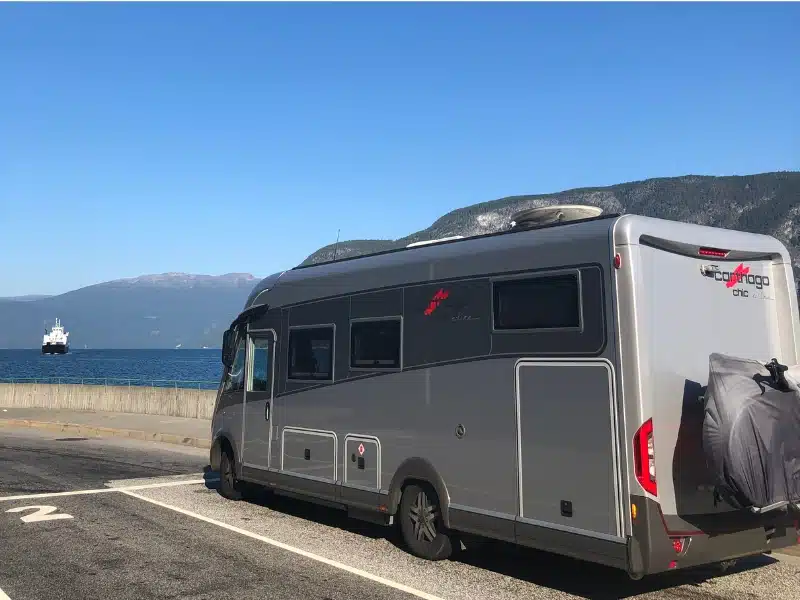
Poland
For motorhomes exceeding a maximum permissible weight of 3.5 tons, toll charges apply not only on motorways but also on most first-class roads. The national company e-Toll oversees toll collection on first-class roads and some motorways, while private companies manage toll collection on other motorway sections.
To pay tolls within the e-Toll system network, users must utilize a mobile app, an onboard unit, or an external location system. Meanwhile, on motorways operated by private entities, tolls can be paid manually at toll booths.
First, grab a cuppa and make sure you have at least 30 minutes to register, then follow these steps:
- Click ‘Login to the OC’ in the top left of this web page
- Choose the login method and confirm your identity
- Specify that you wish to register a natural person
- Complete all the mandatory fields to create an OCA billing account
- Add your vehicle
- Choose the prepaid account option (it’s a lot simpler than postpaid)
- Add the e-TOLL app as the location device
- Download the app (search for e-TOLL PL) and pair it with the vehicle using the business ID number provided
- Activate the location device in the OCA account
You must remember to activate the app when you’re travelling on a toll road.
Portugal
Toll roads in Portugal are complicated! Travel on all Portuguese motorways is subject to tolls, which fall into two categories – conventional tolls with booths and those that are exclusively electronic.
For motorhomes with a maximum authorised weight of more than 3.5t, the same charging rules apply as for any passenger vehicle. Vehicles over 1.1m with two axles are deemed class 2 and with three axles, class 3.
Motorways with Toll Booths
On motorways with toll booths, payment is made with cash or card, or through the Via Verde system. Via Verde is an electronic toll system where the toll fee is debited directly from the registered debit or credit card. To use the scheme you must get a Via Verde identifier tag, which can be obtained through the Via Verde Visitors visitors portal.
On some motorways, there are no toll booths but an entirely electronic collection system, and your vehicle is detected as it passes the electronic gateways along the motorway.
Motorways with Electronic Systems
To make payment on these motorways, vehicles with foreign number plates can register at PortugalTolls. There are several ways to pay for the use of the electronic toll roads:
The Easytoll system associates the payment card to the vehicle’s license plate and the fee is debited directly from the credit or debit card. This is the easiest option for foreign-registered vehicles.
A Tollcard is a pre-paid card with a fixed prepaid amount that is linked to the licence plate and is valid for one year. You can purchase a prepaid Toll card here.
Having spent quite a bit of time touring in Portugal, we think the temporary Via Verde device is the best option. It’s the only option that is valid throughout the Portuguese highways network, highways with electronic-only tolls and designated lanes on traditional tolls.
RELATED POST: Campervanning in Portugal: Complete Guide for 2024
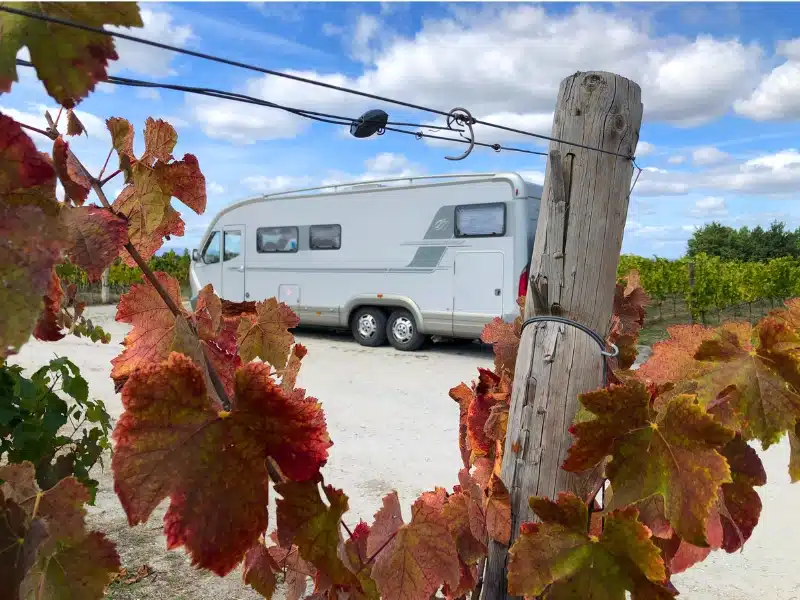
Romania
In Romania, the motorway toll is compulsory not only for motorways but also for other state roads outside of municipalities.
Vignettes are available for motorhomes weighing over 3.5 tons, which are classed as Category A, the same as cars. There are options for validity periods of 1, 10, 30 or 60 days, or an annual pass. These can be purchased as e-vignettes online or the more traditional sticker type vignette at common points of sale like petrol stations.
We always use Digitale Vignette because they always have the best prices, but there are many other authorised providers online.
Serbia
Tolls are compulsory on all Serbian motorways, except on the A3 through the centre of Belgrade.
Motorhomes over 3,500kgs with either two ot three axles being classed as Category 3. Toll fees in Serbia are collected at toll gates on motorways and can be paid with cash in local currency Serbian dinar, euros, or a credit card.
Slovakia
In Slovakia, M1 vehicles, regardless of weight, are classed the same as a car. Motorhomes are generally classed as M1 (no more than eight seats in addition to the driver seat), meaning you can purchase the same vignette as a car.
E-vignettes are provided online by Eznamka and can be purchased for 10, 30 or 365 days.
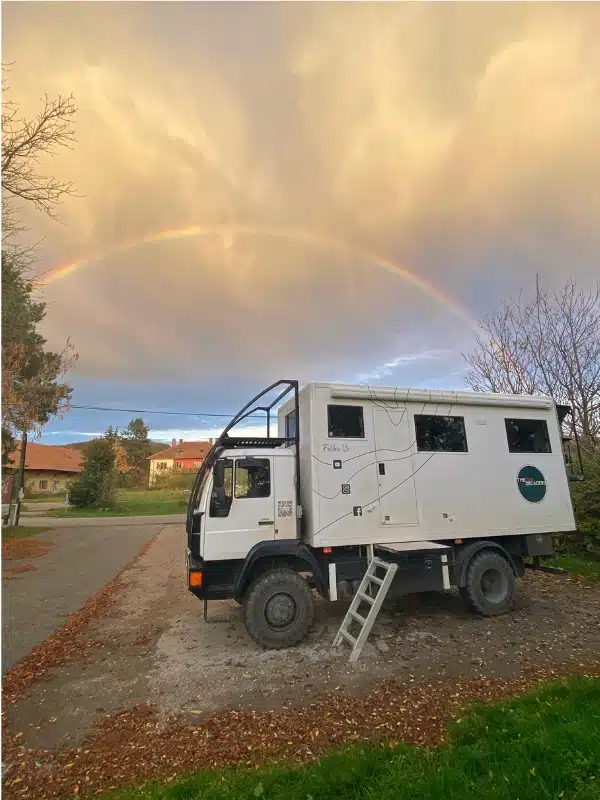
Slovenia
All motorhomes over the 3.5t limit are required to use the DarsGo onboard unit, which can be picked up and pre-loaded at the first service station over the border. There is an administrative fee of €10 and then whatever you choose to add to cover the cost of the toll roads you’ll use. You can top-up online using the e-DarsGo self-service portal.
Motorised vehicles with two axles where the maximum permissible mass exceeds 3,500 kg are Class 2, and where the motorhome has three axles, it’s Class 3. The emissions class of the vehicle is also taken into account.
You’ll need the original V5 registration document and a certificate of conformity to evidence your emissions class. If you don’t have this, your vehicle may be deemed as Class 0, meaning you’ll pay the highest level of tolls.
Spain
In January 2020 and September 2021, many Spanish tolls were removed, even for large motorhomes. The AP7 in northern Spain, on the Costa Blanca and Costa del Sol retains some charges, as does the AP2 around Madrid. You’ll know you’re on a toll road because it will be marked ‘AP’ for autopista whereas non-toll roads are marked ‘A’ for autovia.
Toll charges are determined by the type of vehicle and distance travelled. Motorhomes, regardless of weight, are determined to be in the ligeros, or light, vehicle category. Tolls are paid by cash or card at the toll booth.
Sweden
There are no tolls on motorways in Sweden. The city toll is limited to the use of certain roads in the cities of Gothenburg and Stockholm and there is also a bridge toll, which is charged for the Öresund, Sundvall and Motala bridges.
The Swedish Transport Agency states that ‘trucks with residential furnishings’ are exempt from paying the toll related to heavy vehicles over 12,000kgs.
However, you must still register for regular toll payments along with all other Swedish road users. The scheme is operated by Epass24, who use ANPR (number plate recognition) to apply tolls. Registering means you can pay your toll fees automatically and in good time, avoiding the hefty late payment fees.
Switzerland
Typically, the Swiss have made paying for tolls very simple!
Motorhomes over 3.5t will need to pay a lump-sum heavy vehicle charge known as PSVA to use any motorways and class 1 and 2 national roads in Switzerland.
You can purchase the PSVA ticket for a specified period of time, for ten individual days (in the Via app only) or for a month’s usage from the Via portal. We found the website to be a bit glitchy, but the app is really easy to use and navigate.
Turkey
There are currently two types of toll systems in Turkey, but the older OGS system is being phased out and on many roads the booths and gates have been removed. The newer HGS system is an electronic chip that allows you to pay your toll automatically via a windscreen vignette.
Turkey determines the class of vehicle on the length of your wheelbase and number of axles. You are likely to be either: Category 1, 2 axles, axle spacing less than 3.20m: Category 2, 2 axles, axle spacing over 3.20m; or Category 3, Vehicle with 3 axles. The class of your motorhome is combined with the distance travelled to calculate the toll fee.
To register your vehicle, head to the nearest PTT (Post Office) with your passport and vehicle registration document within 14 days of entering Turkey. You can still use toll roads in the meantime – where there is no payment option at a toll booth, your journey will be logged against your motorhome’s registration number and the cost of your journeys is tallied up when you register at the PTT.
The PTT will register your vehicle and provide you with an HGS sticker for your windscreen for a small fee. Once done, ask them to load your HGS account with lira – 1000TRY (around £25) will likely be enough.
When you pass through a motorway toll gate, it should display your balance. You need to be a Turkish resident to top up using the HGS app or at an ATM, meaning a PTT trip is necessary if you use up your initial load.
When you leave Turkey, the police will check whether you have outstanding toll fees to pay. If you do, they will collect the fee plus a fine for not paying it in the first place!
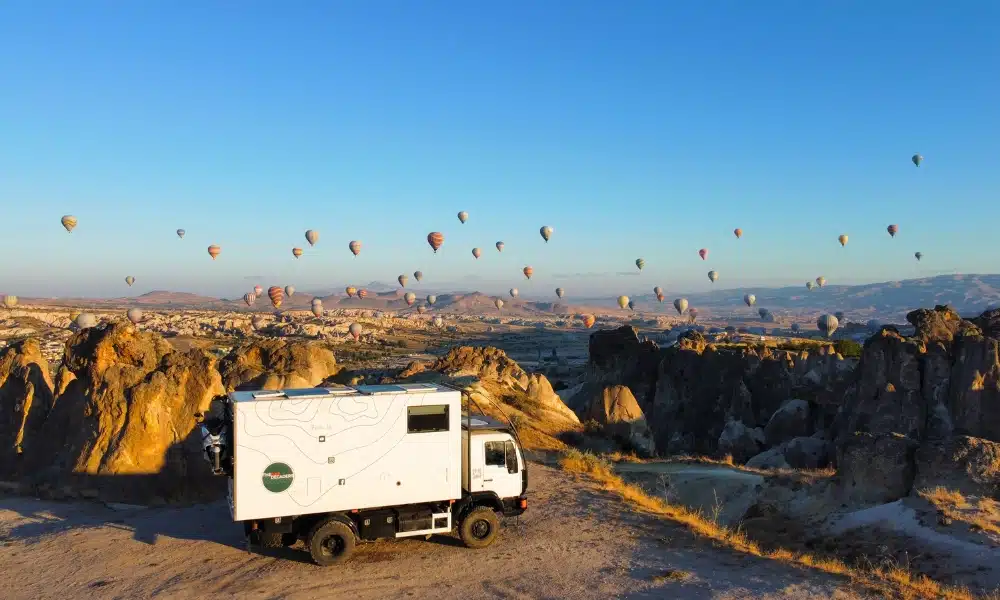
United Kingdom
There are no toll roads in Northern Ireland or Scotland. Elsewhere, the UK’s toll roads are paid for either at a toll booth or using an online system which detects your number plate though ANPR (automatic numberplate recognition).
You can find a list of toll roads in the UK, and their charges, on the UK Govt website. On some toll roads motorhomes are charges the same as a passenger car, but on privately run roads, heavy motorhomes may have to pay more.
Are you looking for more motorhome tips & tricks? Check out these top posts…
Must-Have Storage Ideas for Your Home on Wheels
Must-Have Mobility Aids for a Comfortable Motorhome Journey
MOT for Long-Term Travel Outside the UK: All You Need to Know
Reinvent Your Life: The Ultimate Gap Year Guide for Over 50s
Motorhome Life: Should You Sell Up to Travel Like We Did?
Touring Europe in a Motorhome: The Best & Only Guide You Need!
Love it? Pin it!
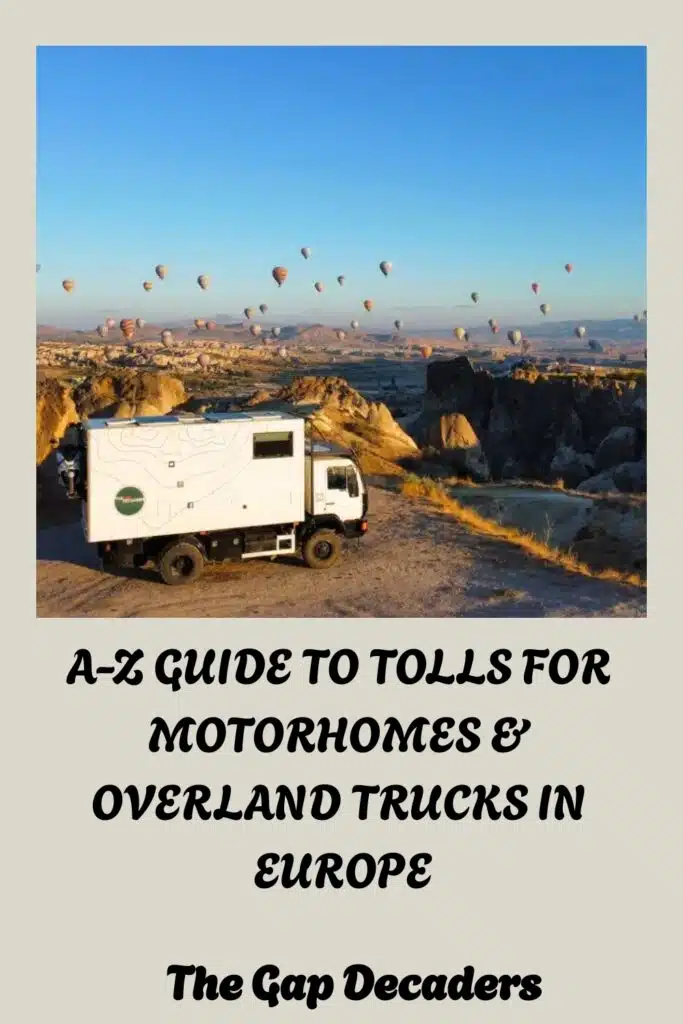
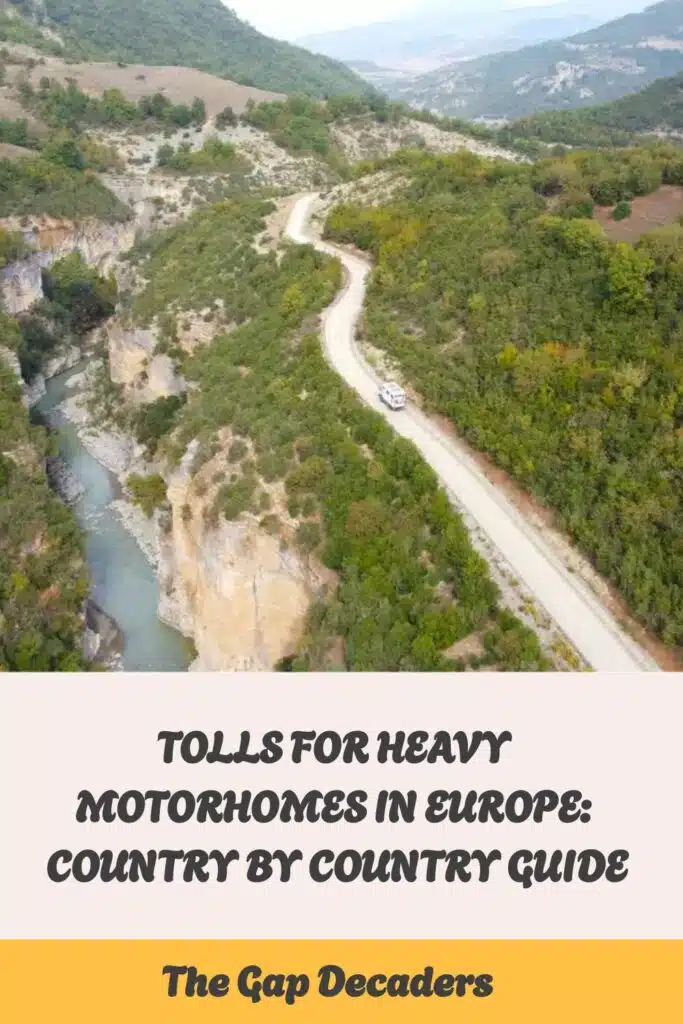

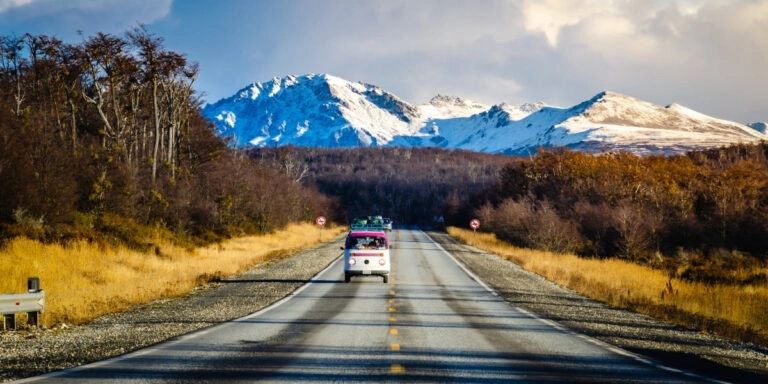
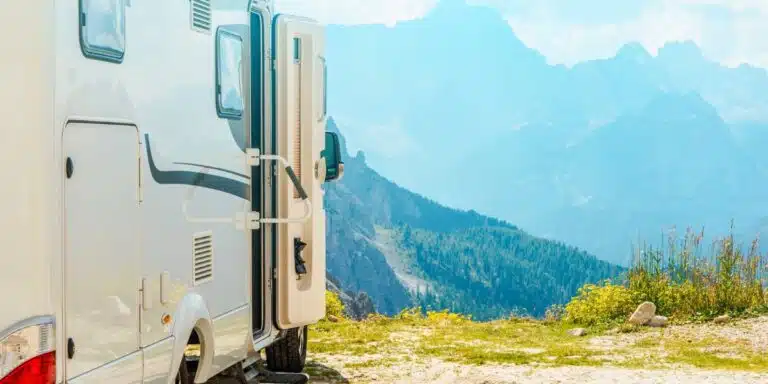



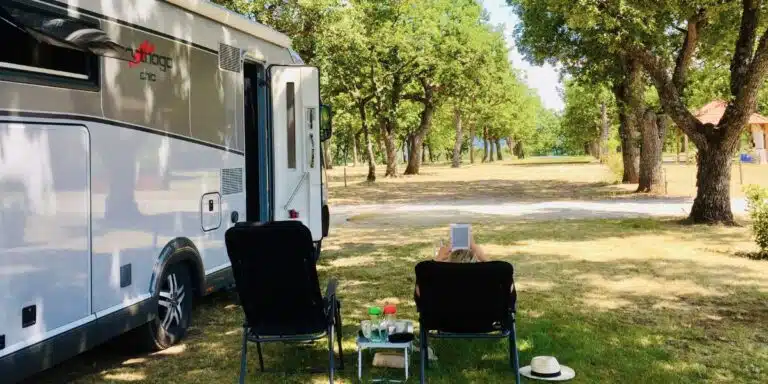
Thanks Darku, that’s really helpful. I have updated the relevent section 🙂
Hi in Bulgaria from 2.2024 for RV over 3500kg you need only E Vignette, no more toll for the road. I have allready back from Turkey and have pay in Bulgaria credential .